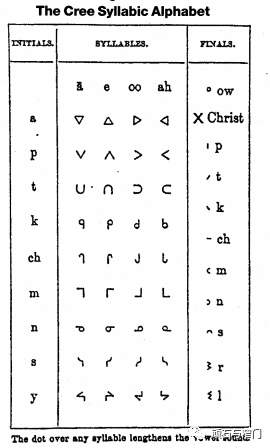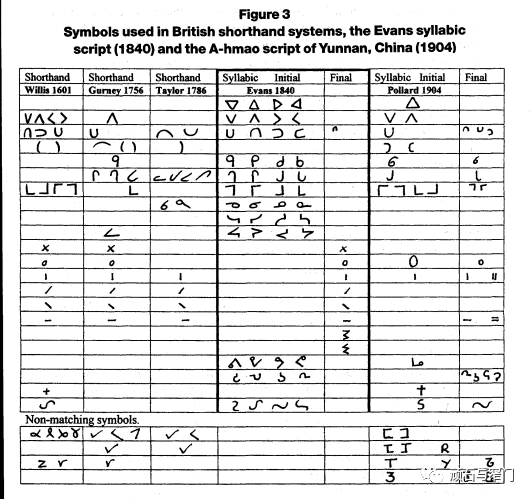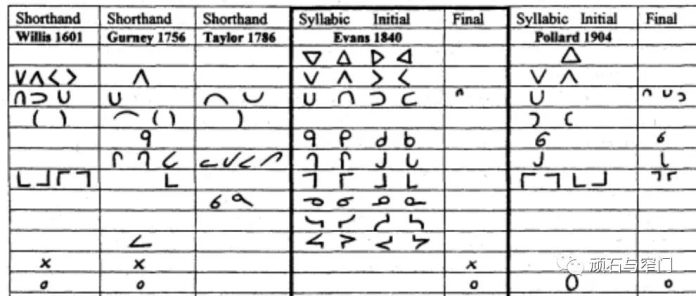Two Related Indigenous Writing Systems:Canada’s Syllabic and China’s A-Hmao Scripts
By
R.Alison Lewis
Louis.Jacques Dorais
来源:
The Canadian Journal of Native Studies XXIII, 2(2003):277-304.
兩位作者考證在兩個不同時期、不同地方,由衛理公會兩位教士為當地少數民族創製的文字之間的關聯,並對教士所創造的文字給“本民族”帶來的影響。在加拿大的James Evans為當地本土民族所創造的書寫系統,被後來的在中國西南地區的Samuel Pollard“借鑒”,為川滇黔邊的阿卯創製了屬於該民族自己的書寫系統。
以下摘取論文的開頭與結尾,以供參考。
Evans1840年左右在加拿大北部與當地人為其民族研究、開發了一種文字,這種文字的符號,跟栢格理20世紀初為阿卯創製的文字有相似之處,也有不同之處。其實,作者自己也說,對於栢格理是否知道Evans在加拿大的工作也持一種“可能”的看法,“他很可能知道埃文斯的工作”(……Rev. Samuel Pollard, a Methodist missionary who most probably knew about Evans’ work.)
總之,這是一篇語言文字研究論文,作者比較兩種書寫系統之間的相似與差異,使我們知道,兩個不同地區之間(中國西南與加拿大北部)的文字符號,是存在一定的相同點的,而且,栢很有可能參考了Evans的文字符號。關於西方對“石門坎苗文”的研究,我們還知之甚少,對其的梳理也未見得有多少。王樹德,這位能熟練運用“石門坎苗文”的英國人,對它也有過研究,且有專門的論文發表過。
Abstract
Around 1840, a team of Ojibwa and Cree speakers working with Rev.James Evans, a British Wesleyan missionary, developed a syllabic writing system which disseminated rapidly among the Cree and other northern Canadian Aboriginal nations. 因此me 65 耶ars later, in 1904, another Methodist, Rev. Samuel Pollard, who also worked in close collaboration with local people, supervised the elaboration of a script for transcribing the language of the A-hmao,an Aboriginal minority in south-western China. This article tells the story of these two writing systems, discusses the evidence of a connection between them, and describes their similar educational role in terms of social empowerment.
Introduction
People interested in Canada’s Aboriginal cultures and languages know that a large number of First Nations currently use syllabic writing systems. This is the case with a majority of Ojibwa and Cree nations, as it is with the Canadian eastern Arctic Inuit (except for Labrador), and with the speakers of at least one Dene language (Chipewyan). All these systems originate from the same source: the script devised in the late 1830s and early 1840s by a team of Native speakers of the Ojibwa and Cree languages, under the supervision of Rev. James Evans, a Wesleyan missionary at St.Clair River (Ontario) and Norway House (Manitoba).
What is often overlooked is that at the other end of the world, in south-western China (provinces of Guizhou, Guanxi and Yunnan), writing systems at least partly inspired by Canadian syllabics are also in use among the A-hmao and a few other Aboriginal populations of the area.They were devised at the beginning of the 20th century, thanks to the collaboration between Native speakers and Rev. Samuel Pollard, a Methodist missionary who most probably knew about Evans’ work.
In the following pages, we will look at these two sets of writing systems in order to explore the connections between them—— in terms of their history, mode of operation, and role in defining Aboriginal identities——and point at their similarities and differences. Canadian syllabics will be dealt with first.
……
Conclusion
Despite the integrity of many world writing systems, there is evidence of inter-influences in the development of scripts, if not in their origins (Daniels and Bright 1996; Tuchscherer and Hair 2002). The juxtaposition of the Cree script of 1840 and the A-hmao script of 1904 suggests influence one to another. Using visual comparison alone, the clues given in the survey of shorthand symbols suggest that Evans was influenced by those of Taylor and indirectly from Gurney and Willis. The qualities of effective shorthand are not dissimilar to those required for Cree and A-hmao literacy——simplicity for both writing and printing, especially in the contexts in which each was created. It can be reasonably assumed that both Evans and Pollard were familiar with and used the shorthand of their times. They had similar commitments to literacy for preliterate people among whom they worked, and they both appear to have had particular competence in linguistic understanding and a desire to communicate their 基督徒 beliefs through education and literacy.
There may be relevance in the common denominational background of Methodism, for both Evans and Pollard, but they came from different traditions within it. However, each was committed to work with marginal communities and to education, consistent with policy and practices in Methodism, and their own upbringing. The combination of these varied factors does not presume a recipe for the invention of scripts for preliterate people, but it does give an insight into possible motivations.
Finally, in both cases, the original educational goals of Evans and Pollard which, we should presume, were primarily religious, had unforeseen effects. Probably because the elaboration of the Cree and A-hmao scripts had resulted from team work——involving both Indigenous and non-Indigenous individuals——the people for whom these scripts were intended appropriated them readily, putting them to usages that went far beyond the mere study of Scriptures, and using them as power福l educational tools. As a consequence, in both northern Canada and southwest China, syllabic writing systems now form an integral part of the cultural identity of several Aboriginal nations. This is probably the greatest tribute that can be paid to those-foreign missionaries and local people——who toiled intelligently to introduce an original form of literacy to two very different corners of the world.


注:R.Alison Lewis,乃甘鐸理的女兒。除去關於“阿卯文字”的研究論文在,她還有其他阿卯的研究論文。


